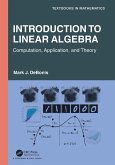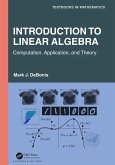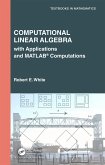Ruriko Yoshida
Linear Algebra and Its Applications with R
Ruriko Yoshida
Linear Algebra and Its Applications with R
- Broschiertes Buch
- Merkliste
- Auf die Merkliste
- Bewerten Bewerten
- Teilen
- Produkt teilen
- Produkterinnerung
- Produkterinnerung
The book developed from the need to teach a linear algebra course to students focused on data science and bioinformatics programs. This textbook provides students a theoretical basis which can then be applied to the practical R and Python problems, providing the tools needed for real-world applications.
Andere Kunden interessierten sich auch für
![Linear Algebra and Its Applications with R Linear Algebra and Its Applications with R]() Ruriko YoshidaLinear Algebra and Its Applications with R110,99 €
Ruriko YoshidaLinear Algebra and Its Applications with R110,99 €![Linear Algebra With Machine Learning and Data Linear Algebra With Machine Learning and Data]() Crista ArangalaLinear Algebra With Machine Learning and Data86,99 €
Crista ArangalaLinear Algebra With Machine Learning and Data86,99 €![Linear Algebra Linear Algebra]() James R. KirkwoodLinear Algebra60,99 €
James R. KirkwoodLinear Algebra60,99 €![Introduction To Linear Algebra Introduction To Linear Algebra]() Mark J. DeBonisIntroduction To Linear Algebra49,99 €
Mark J. DeBonisIntroduction To Linear Algebra49,99 €![Introduction to Linear Algebra Introduction to Linear Algebra]() Mark J. DeBonisIntroduction to Linear Algebra91,99 €
Mark J. DeBonisIntroduction to Linear Algebra91,99 €![Computational Linear Algebra Computational Linear Algebra]() Robert E. White (North Carolina State University, Raleigh, USA)Computational Linear Algebra64,99 €
Robert E. White (North Carolina State University, Raleigh, USA)Computational Linear Algebra64,99 €![Elementary Linear Algebra Elementary Linear Algebra]() James R. KirkwoodElementary Linear Algebra50,99 €
James R. KirkwoodElementary Linear Algebra50,99 €-
-
-
The book developed from the need to teach a linear algebra course to students focused on data science and bioinformatics programs. This textbook provides students a theoretical basis which can then be applied to the practical R and Python problems, providing the tools needed for real-world applications.
Produktdetails
- Produktdetails
- Textbooks in Mathematics
- Verlag: Taylor & Francis Ltd
- Seitenzahl: 424
- Erscheinungstermin: 26. August 2024
- Englisch
- Abmessung: 234mm x 156mm x 23mm
- Gewicht: 640g
- ISBN-13: 9781032020525
- ISBN-10: 1032020520
- Artikelnr.: 71234720
- Herstellerkennzeichnung
- Libri GmbH
- Europaallee 1
- 36244 Bad Hersfeld
- gpsr@libri.de
- Textbooks in Mathematics
- Verlag: Taylor & Francis Ltd
- Seitenzahl: 424
- Erscheinungstermin: 26. August 2024
- Englisch
- Abmessung: 234mm x 156mm x 23mm
- Gewicht: 640g
- ISBN-13: 9781032020525
- ISBN-10: 1032020520
- Artikelnr.: 71234720
- Herstellerkennzeichnung
- Libri GmbH
- Europaallee 1
- 36244 Bad Hersfeld
- gpsr@libri.de
Dr. Ruriko Yoshida is an Associate Professor of Operations Research at the Naval Postgraduate School. She received her Ph.D. in Mathematics from the University of California, Davis. Her research topics cover a wide variety of areas: applications of algebraic combinatorics to statistical problems such as statistical learning on non-Euclidean spaces, sensor networks, phylogenetics, and phylogenomics. She teaches courses in statistics, stochastic models, probability, and data science.
Preface. 1. Systems of Linear Equations and Matrices. 1.1. Introductory
Example from Statistics. 1.2. What is a Matrix? What is a Vector? 1.3.
Systems of Linear Equations. 1.4. Echelon Form. 2. Matrix Arithmetic. 2.1.
Introductory Example from Statistics. 2.2. Matrix Operations. 2.3.
Properties of Matrix Operations and Matrix Inverse. 2.4. Elementary
Matrices. 2.5. Discussion. 3. Determinants. 3.1. Introductory Example from
Astronomy. 3.2. Determinants. 3.3. Introduction of Determinants. 3.4.
Properties of Determinants. 3.5. Cramer's Rule. 3.6. Discussion. 4. Vector
Spaces. 4.1. Introductory Example from Data Science. 4.2. Vector Spaces and
Subspaces. 4.3. Null Space, Column Space, and Row Space. 4.4. Spanning Sets
and Bases. 4.5. Coordinates Systems and Change of Basis. 4.6. Discussion.
5. Inner Product Space. 5.1. Introductory Example from Statistics. 5.2.
Inner Products. 5.3. Angles and Orthogonality. 5.4. Discussion. 6. Eigen
Values and Eigen Vectors. 6.1. Introductory Example from Data Science:
Image Compression. 6.2. Eigen Values and Eigen Vectors. 6.3.
Diagonalization. 6.4. Discussion. 7. Linear Regression. 7.1. Introductory
Example from Statistics. 7.2. Simple Linear Regression. 7.2. Simple Linear
Regression. 8. Linear Programming. 8.1. Introductory Example from
Optimization. 8.2. Linear Programming. 9. Network Analysis. 9.1.
Introductory Example from Network Analysis. 9.1. Introductory Example from
Network Analysis. 9.2. Graphs and Networks. 9.3. Discussion. Appendices.
A) Introduction to RStudio via Amazon Web Service (AWS). B) B Introduction
to R. Bibliography. Index.
Example from Statistics. 1.2. What is a Matrix? What is a Vector? 1.3.
Systems of Linear Equations. 1.4. Echelon Form. 2. Matrix Arithmetic. 2.1.
Introductory Example from Statistics. 2.2. Matrix Operations. 2.3.
Properties of Matrix Operations and Matrix Inverse. 2.4. Elementary
Matrices. 2.5. Discussion. 3. Determinants. 3.1. Introductory Example from
Astronomy. 3.2. Determinants. 3.3. Introduction of Determinants. 3.4.
Properties of Determinants. 3.5. Cramer's Rule. 3.6. Discussion. 4. Vector
Spaces. 4.1. Introductory Example from Data Science. 4.2. Vector Spaces and
Subspaces. 4.3. Null Space, Column Space, and Row Space. 4.4. Spanning Sets
and Bases. 4.5. Coordinates Systems and Change of Basis. 4.6. Discussion.
5. Inner Product Space. 5.1. Introductory Example from Statistics. 5.2.
Inner Products. 5.3. Angles and Orthogonality. 5.4. Discussion. 6. Eigen
Values and Eigen Vectors. 6.1. Introductory Example from Data Science:
Image Compression. 6.2. Eigen Values and Eigen Vectors. 6.3.
Diagonalization. 6.4. Discussion. 7. Linear Regression. 7.1. Introductory
Example from Statistics. 7.2. Simple Linear Regression. 7.2. Simple Linear
Regression. 8. Linear Programming. 8.1. Introductory Example from
Optimization. 8.2. Linear Programming. 9. Network Analysis. 9.1.
Introductory Example from Network Analysis. 9.1. Introductory Example from
Network Analysis. 9.2. Graphs and Networks. 9.3. Discussion. Appendices.
A) Introduction to RStudio via Amazon Web Service (AWS). B) B Introduction
to R. Bibliography. Index.
Preface. 1. Systems of Linear Equations and Matrices. 1.1. Introductory
Example from Statistics. 1.2. What is a Matrix? What is a Vector? 1.3.
Systems of Linear Equations. 1.4. Echelon Form. 2. Matrix Arithmetic. 2.1.
Introductory Example from Statistics. 2.2. Matrix Operations. 2.3.
Properties of Matrix Operations and Matrix Inverse. 2.4. Elementary
Matrices. 2.5. Discussion. 3. Determinants. 3.1. Introductory Example from
Astronomy. 3.2. Determinants. 3.3. Introduction of Determinants. 3.4.
Properties of Determinants. 3.5. Cramer's Rule. 3.6. Discussion. 4. Vector
Spaces. 4.1. Introductory Example from Data Science. 4.2. Vector Spaces and
Subspaces. 4.3. Null Space, Column Space, and Row Space. 4.4. Spanning Sets
and Bases. 4.5. Coordinates Systems and Change of Basis. 4.6. Discussion.
5. Inner Product Space. 5.1. Introductory Example from Statistics. 5.2.
Inner Products. 5.3. Angles and Orthogonality. 5.4. Discussion. 6. Eigen
Values and Eigen Vectors. 6.1. Introductory Example from Data Science:
Image Compression. 6.2. Eigen Values and Eigen Vectors. 6.3.
Diagonalization. 6.4. Discussion. 7. Linear Regression. 7.1. Introductory
Example from Statistics. 7.2. Simple Linear Regression. 7.2. Simple Linear
Regression. 8. Linear Programming. 8.1. Introductory Example from
Optimization. 8.2. Linear Programming. 9. Network Analysis. 9.1.
Introductory Example from Network Analysis. 9.1. Introductory Example from
Network Analysis. 9.2. Graphs and Networks. 9.3. Discussion. Appendices.
A) Introduction to RStudio via Amazon Web Service (AWS). B) B Introduction
to R. Bibliography. Index.
Example from Statistics. 1.2. What is a Matrix? What is a Vector? 1.3.
Systems of Linear Equations. 1.4. Echelon Form. 2. Matrix Arithmetic. 2.1.
Introductory Example from Statistics. 2.2. Matrix Operations. 2.3.
Properties of Matrix Operations and Matrix Inverse. 2.4. Elementary
Matrices. 2.5. Discussion. 3. Determinants. 3.1. Introductory Example from
Astronomy. 3.2. Determinants. 3.3. Introduction of Determinants. 3.4.
Properties of Determinants. 3.5. Cramer's Rule. 3.6. Discussion. 4. Vector
Spaces. 4.1. Introductory Example from Data Science. 4.2. Vector Spaces and
Subspaces. 4.3. Null Space, Column Space, and Row Space. 4.4. Spanning Sets
and Bases. 4.5. Coordinates Systems and Change of Basis. 4.6. Discussion.
5. Inner Product Space. 5.1. Introductory Example from Statistics. 5.2.
Inner Products. 5.3. Angles and Orthogonality. 5.4. Discussion. 6. Eigen
Values and Eigen Vectors. 6.1. Introductory Example from Data Science:
Image Compression. 6.2. Eigen Values and Eigen Vectors. 6.3.
Diagonalization. 6.4. Discussion. 7. Linear Regression. 7.1. Introductory
Example from Statistics. 7.2. Simple Linear Regression. 7.2. Simple Linear
Regression. 8. Linear Programming. 8.1. Introductory Example from
Optimization. 8.2. Linear Programming. 9. Network Analysis. 9.1.
Introductory Example from Network Analysis. 9.1. Introductory Example from
Network Analysis. 9.2. Graphs and Networks. 9.3. Discussion. Appendices.
A) Introduction to RStudio via Amazon Web Service (AWS). B) B Introduction
to R. Bibliography. Index.









